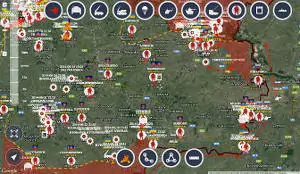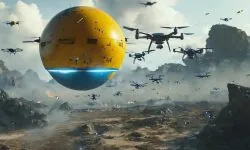On 24 February 2022, at 3:00 GMT Russia launched an attack on Ukraine. Russian President Vladimir Putin dubbed it a “special military operation”. Immediately, part of the international community condemned this attack.
This attack results from a long, multidimensional escalation, with one of the focal node being the crisis in Ukraine, which started in November 2013. To assess and understand today’s war, not to fall in the trap of amazingly widespread psychological operations (propaganda), it is necessary to comprehend the 2013-2014 years.
(Art design: Jean-Dominique Lavoix-Carli with a photo by Mstyslav Chernov/Unframe – CC BY-SA 3.0)
The current 2022 war is globally very polarised, with too many emotions running very high. As a result, publishing publicly objective assessments is difficult. Our work on the war, from detailed assessments and states of play to monitoring and warning on the issue, nonetheless, continues as we are commissioned to carry it out. As a result, publicly, here we only publish selected elements on the war in 2022. Our work on the 2013-2014 roots of the crisis remains publicly available.
The 2013-2014 crisis rapidly became a war. This page is a table of content for the strategic foresight and warning analysis of the crisis, conflict and war in Ukraine we published during 2014.
Our aim was to provide, first, in-depth strategic foresight & warning analysis on the war in Ukraine, starting with identifying and presenting the actors. Second, we used this opportunity to engage in a methodological reflection on the challenges met during the analysis and ways forward to solve them. The lessons learned are useful for all complex crises and were integrated in our methodology.
As a brief introduction, back in 2013 and 2014, the war in Ukraine was a complex war, in as much as it encompasses various multi-dimensional phenomena, classical ones but also novel or relatively surprising ones, compared with what was generally thought of as possible or probable for the future. The second escalation, started during winter 2021 is no less complex and takes its roots in the first period.
The War in Ukraine in 2022 – Selected features

In terms of strategic foresight and warning methodology, the first period of escalation to war in Ukraine was definitely a challenge in various ways. Notably, the conflict being young, the situation was fluid and rapidly evolving, while polarization was at work. Analysts thus had to do two tasks in the same time. First, proper international relations and political analysis for strategic foresight and early warning, which demand time, reflection and knowledge. Notably, we had to consider the evolution of the international context as well as related potential impacts which were multi-dimensional and far-reaching, but may actualize on very different timeframes (see section below “International environment and world order”). Second, and in the same time, analysts had to keep abreast of rapidly evolving developments.
To access this series of articles purchase the Ukraine Crisis Package – Understand the Roots of the Crisis or a membership.
Understand the conflict
The Crisis and its escalation
Conflict in Ukraine – Setting the Stage by Helene Lavoix, 19 May 2014
Methodology, actors and factors
Also available to registered users for the online courses Geopolitical Risks and Crisis Anticipation – Analytical Model and Scenario-building.
- Actors and Factors In Future Threats Analysis (3) – The Crisis in Ukraine, by Helene Lavoix, 21 April 2014.
- Actors Labelling and Factors In Future Threats Analysis (2) – The Crisis in Ukraine, by Helene Lavoix, 21 April 2014.
- Actors and Factors In Future Security Threats Analysis (1) – the Crisis in Ukraine, by Helene Lavoix, 21 April 2014..
The actors
The far right groups
- Conflict in Ukraine – The Far-Right (3): Parties and Battalions, by Helene Lavoix, 17 November 2014.
- Actors mapping – Ultra Nationalist and Far Right Groups in Ukraine (Platinum members and Ukraine access)
- Conflict in Ukraine – The Far-Right (2): Demise or Metamorphosis? by Helene Lavoix, 10 November 2014.
- Ultra-Nationalism and the Far Right in Ukraine (1): Victims and Heroes, by Helene Lavoix, 20 October 2014.
The Separatists in Donbass
- War in Ukraine: Hope, Outrage and Fortitude – The Separatists (2), by Helene Lavoix, 7 July 2014; updated 10 July 2014.
- War and Peace in Ukraine: The Separatists (1), by Helene Lavoix, 30 June 2014.
The Oligarchs
- Actors mapping – Oligarchs, Business and Politics in Ukraine (Platinum members and Ukraine access only)
- Conflict in Ukraine – State of Play – The Oligarchs, by Helene Lavoix, 13 June 2014.
- Conflict in Ukraine – State of Play – The Oligarchic System, by Helene Lavoix, 2 June 2014.
International environment and world order
- Fighting Wars of Narratives, from AQ to IS, Ukraine and Russia – The Red (Team) Analysis Weekly 178, by Helene Lavoix, 13 November 2014.
- An Isolated Russia? Think Again! by Helene Lavoix, 15 September 2014.
- Narratives at War: EU-US vs Russia vs Crowdsourced? – The Red (Team) Analysis Weekly 155, by Helene Lavoix, 5 June 2014.
- War and Weak Signals – The Red (Team) Analysis Weekly 149, by Helene Lavoix, 24 April 2014.
- A strange bipolar world? – The Red (Team) Analysis Weekly 148, by Helene Lavoix, 17 April 2014.
- A case study in escalation: NATO, the U.S. and Russia – The Red (Team) Analysis Weekly 146, by Helene Lavoix, 3 April 2014.
- Risks on the US Dollar Supremacy? – The Red (Team) Analysis Weekly 145, by Helene Lavoix, 27 March 2014.
- Towards a 19th Century Order? – The Red (Team) Analysis Weekly 143, by Helene Lavoix, 13 March 2014.
- Beyond Ukraine, towards Change in the World Order? – The Red (Team) Analysis Weekly 142, by Helene Lavoix, 6 March 2014.
Impacts on the corporate world
- Impacts of the Conflict in Ukraine – Geopolitics, Uncertainties and Business, 28 November 2016 (3000 words, approx. 15 pages).
- Lessons from the Conflict in Ukraine – Geopolitics, Uncertainties and Business, 5 December 2016 (2613 words, approx. 13 pages).








